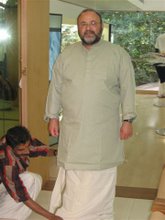

This post is for camera nuts and if you're not into photography you definitely should stop reading now. Unless you are considering dusting off that SLR that's been sitting around for so long. So here's the news: Thank you Kodak for going against the grain (pun definitely intended!). Thank you thank you thank you for bringing back to life the best print film ever made, now faster than ASA 25. Some of my indoor, artificially lit digital shots that are not perfectly exposed because I am using the M8 with the older Leica flash on "Auto" require too much post-processing, especially of people's faces that are within the frame but not the main subject. And they still come out looking awful. I have always been flash averse and I am never going to put one of those enormous and expensive Metz gizmos on top of my rangefinder. I have noticed the same mud-faced people phenomenon using Nikon digital armed with a much more versatile, bouncable and dedicated flash.
THE BOTTOM LINE: ANOTHER GREAT REASON TO KEEP SHOOTING FILM! Maybe it's just me, but here's what I think. You are never gonna get faces in your pix that look like zombies from the center of the earth with scans from color positive film negatives! I shot a roll of this magnificent stuff, took it to Walgreen's. The guy told me he could do it in a few hours, but heck, I'm still old school and I can wait a day. Used to wait a week for Kodachromes from Fairlawn, NJ! Got the negatives and a CD for 5.99. Even at a modest drug-store 1 MB or so the scans were astonishing. The resolution of this film is beyond belief. I don't know what the cost of getting a gazillion megapixels and a full-frame sensor would be merely to replicate this quality. If I want a custom enlargement, all I need to do is have one made by the pros! Drugstore scan at 1 MB is fine for uploading to web, not too big, not too small. The main point, and best part, however, is that all the faces look human. I got 100% perfect exposures with the older Leica p.o.c. flash but of course this time I was using the M7 and TTL. So one could say it wasn't really my doing, and they would be right: it is Kodak's doing!
PREDICTION: Just as the movie theaters will increasingly have to go 3-D to stay alive, I think that stereo photography will make a comeback. A market will emerge for better and more convenient ways to make, share, and view 3-D, perhaps even holographic images. I am still trying to figure out how to work with depthmaps for 2-D conversions for best results, and have uploaded my latest efforts (above). When I get my beam splitter I will start to share results of real stereo pairs, so get those 3-D glasses ready (there are a few online sources). If you have a collection of old film camera lens filters lying around, and a big pair of dollar-store reader eyeglass frames that you can pop the lenses out of, you can make your own like the one pictured above.
